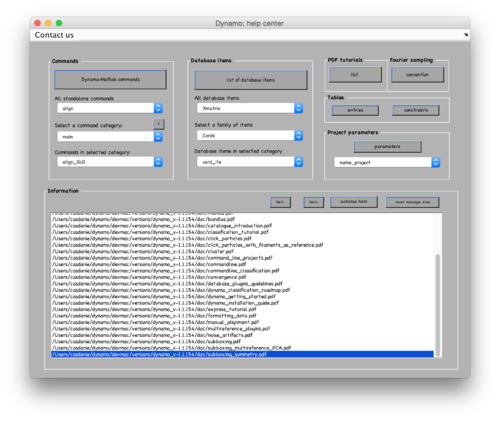Difference between revisions of "Getting help"
(Created page with " ==Online help== We aim at centralizing the information in our wiki. You can open it from the command line as: <tt>dwiki</tt> or indicating and article. <tt>dwiki table<>...") |
|||
| (3 intermediate revisions by the same user not shown) | |||
| Line 8: | Line 8: | ||
or indicating and article. | or indicating and article. | ||
| − | <tt>dwiki table<> | + | <tt>dwiki table</tt> |
Even if you don't if the article exists, you can also try your look and launch searches in the wiki. | Even if you don't if the article exists, you can also try your look and launch searches in the wiki. | ||
| Line 31: | Line 31: | ||
Very often the problem is not the syntax of the command, but remembering the command itself. | Very often the problem is not the syntax of the command, but remembering the command itself. | ||
| − | ===By functionality=== | + | ===By functionality: <tt>dapropos</tt>=== |
<tt>dapropos</tt> finds commands grouped by their areas of functionality. | <tt>dapropos</tt> finds commands grouped by their areas of functionality. | ||
| Line 43: | Line 43: | ||
===By name: <tt> dlookfor </tt>=== | ===By name: <tt> dlookfor </tt>=== | ||
| − | <tt>dlookfor</tt> will look for commands that contain a string in the name. | + | <tt>dlookfor</tt> will look for commands that contain a given string in the name. |
| − | This commands might take some time for execution, as it will search in all the packages inside ''Dynamo'', and not only on the user level functions (those starting with <tt>dynamo_</tt>. | + | This commands might take some time for execution, as it will search in all the packages inside ''Dynamo'', and not only on the user level functions (those starting with <tt>dynamo_</tt>). |
| + | |||
| + | Some flags are available for <tt>dlookfor</tt>, for instance <tt>icnq</tt> to show only class names (with qualified paths) | ||
| + | <tt>>> dlookfor slice -icnq </tt> | ||
| + | <tt>dSlice</tt> | ||
| + | <tt>dVolumeSlice</tt> | ||
| + | <tt>dpkam.Slice</tt> | ||
| + | <tt>dpktomo.volume.slices.Slice</tt> | ||
| + | <tt>dpktomo.volume.slices.SliceGraphic</tt> | ||
===By code content: <tt>dgrep</tt> === | ===By code content: <tt>dgrep</tt> === | ||
| Line 59: | Line 67: | ||
opens a GUI where the user can check different conventions (i.e., for tables, missing wedge codes), access the list of shipped pdf tutorials and check the syntax of commands, project parameters or database elements. | opens a GUI where the user can check different conventions (i.e., for tables, missing wedge codes), access the list of shipped pdf tutorials and check the syntax of commands, project parameters or database elements. | ||
| + | |||
| + | [[File:dhelp.png|thumb|center|500px| <tt>dhelp</tt> window showing the list of available pdf tutorials]] | ||
Latest revision as of 14:35, 20 May 2016
Contents
Online help
We aim at centralizing the information in our wiki. You can open it from the command line as:
dwiki
or indicating and article.
dwiki table
Even if you don't if the article exists, you can also try your look and launch searches in the wiki.
dwiki table tilt
Help on commands
Every command in Dynamo has a header that explains its syntax. This help can be visualized with (for instance, for the dfsc function)
help dfsc
to see the help on the command line, or with
doc dfsc
to generate the help in a browser. This option may be useful for commands with many syntax options.
Finding commands
Very often the problem is not the syntax of the command, but remembering the command itself.
By functionality: dapropos
dapropos finds commands grouped by their areas of functionality.
>> dapropos
lists the functionality areas defined in Dynamo, and
>> dapropos table
will list the main commands attached to the table functionality area.
By name: dlookfor
dlookfor will look for commands that contain a given string in the name.
This commands might take some time for execution, as it will search in all the packages inside Dynamo, and not only on the user level functions (those starting with dynamo_).
Some flags are available for dlookfor, for instance icnq to show only class names (with qualified paths)
>> dlookfor slice -icnq dSlice dVolumeSlice dpkam.Slice dpktomo.volume.slices.Slice dpktomo.volume.slices.SliceGraphic
By code content: dgrep
dgrep will look for appearances of a given string inside the code of any Dynamo function.
This commands might take some time for execution, and is typically used by developers.
Help center
This help center comes in handy when using Dynamo without internet connection.
dhelp
opens a GUI where the user can check different conventions (i.e., for tables, missing wedge codes), access the list of shipped pdf tutorials and check the syntax of commands, project parameters or database elements.
